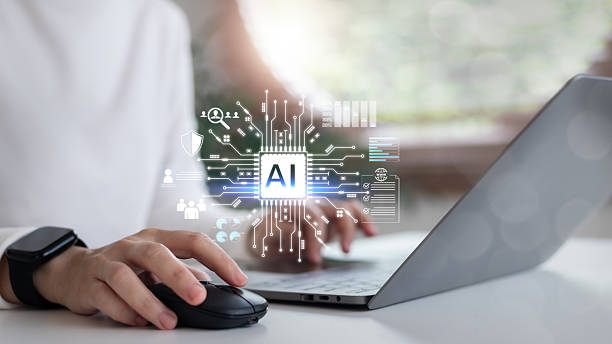### What is an Artificial Intelligence Robot and How Does it Work?
![]()
An Artificial Intelligence Robot, or AI-powered Robot, is a combination of two important technological fields: robotics and artificial intelligence.
In simple terms, an AI robot is a physical machine that, using algorithms and AI techniques, is capable of performing tasks that were previously only performable by humans.
These tasks can include learning, reasoning, problem-solving, pattern recognition, and decision-making.
These robots use sensors and cameras to understand their surrounding environment, and use powerful processors to analyze data and make appropriate decisions.
AI robots are used in various industries, including manufacturing, healthcare, customer service, agriculture, and even space exploration.
AI robots play an important role in transforming industries by improving efficiency, reducing costs, and increasing accuracy.
For example, in production lines, AI robots can perform repetitive and dangerous tasks, while in hospitals, surgical robots perform complex operations with high precision.
AI robots, as a powerful tool, help improve the quality of human life, and will have a more prominent role in our daily lives in the future.
In fact, an AI robot is more than just a programmed machine.
These robots are capable of learning from their experiences and can make intelligent decisions in new and unexpected situations.
This capability distinguishes AI robots from traditional robots and makes them a powerful and flexible tool.
Did you know that the first impression customers have of your company is your website? With a powerful corporate website from Rasaweb, multiply the credibility of your business!
✅ Exclusive and eye-catching design tailored to your brand
✅ Improving user experience and increasing customer acquisition
⚡ Get free advice!
Main Components of an AI Robot
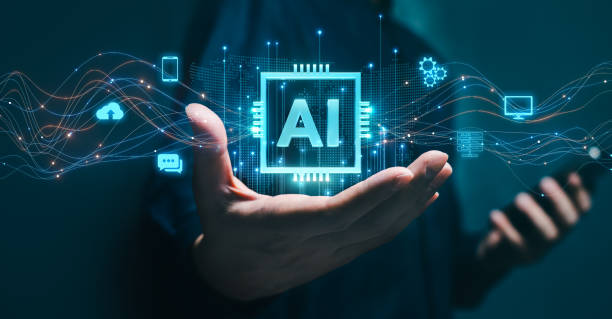
An AI robot consists of various components, each of which plays an important role in the overall performance of the robot.
These components include sensors, processors, actuators, and AI software.
Sensors are responsible for collecting information from the surrounding environment.
This information can include images, sounds, temperature, pressure, and other environmental data.
Processors are responsible for analyzing the data collected by the sensors and making appropriate decisions.
Processors use AI algorithms to identify patterns, predict events, and plan actions.
Actuators are responsible for performing physical actions.
These actions can include moving, grabbing objects, speaking, and other physical activities.
AI software is the thinking brain of the robot and includes algorithms and machine learning models that allow the robot to learn, reason, and decide.
This software is constantly learning and improving, and optimizes the robot’s performance using new data.
Ultimately, the interaction between these components allows an AI robot to operate independently in its environment and perform complex tasks.
Artificial Intelligence
In short, sensors collect information, processors analyze information, actuators perform physical actions, and AI software coordinates these components.
Applications of AI Robots in Various Industries
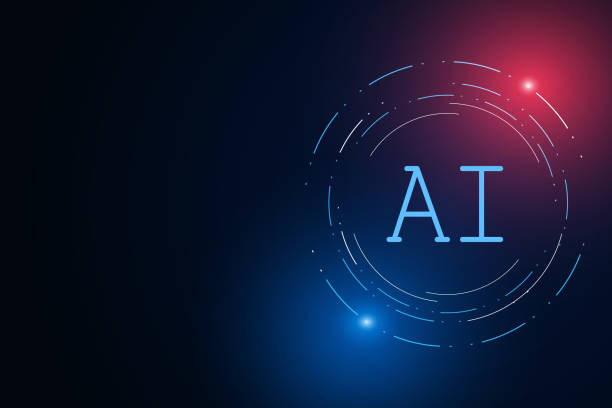
AI robots have extensive applications in various industries and significantly improve performance and efficiency.
In the manufacturing industry, AI robots are used to perform repetitive and dangerous tasks such as welding, painting, and assembling parts.
These robots increase production with high accuracy and speed and reduce human errors.
In the field of health, surgical robots perform complex operations with high precision and help doctors provide more effective treatments.
Nurse robots also help patients in hospitals and perform care tasks.
In the customer service industry, AI robots respond to customers as virtual assistants and solve their problems.
These robots are available 24 hours a day and can serve a large number of customers simultaneously.
In the agricultural industry, AI robots are used for planting, tending, and harvesting crops.
These robots use sensors and cameras to check the condition of the soil and plants and make appropriate decisions for irrigation, fertilization, and spraying.
Finally, in the space exploration industry, AI robots are used to explore other planets and collect information.
These robots can operate independently in harsh and dangerous space conditions and help scientists learn more about the universe.
AI applications are increasing day by day in industries.
| Application | Description |
|---|---|
| Welding | Performing welding with high accuracy and speed |
| Painting | Painting parts with uniform quality |
| Assembly | Assembling parts accurately and without error |
| Application | Description |
|---|---|
| Surgery | Performing complex surgical procedures with high precision |
| Nursing | Helping patients and performing care tasks |
| Diagnosis | Diagnosing diseases by analyzing medical data |
Advantages and Disadvantages of Using AI Robots
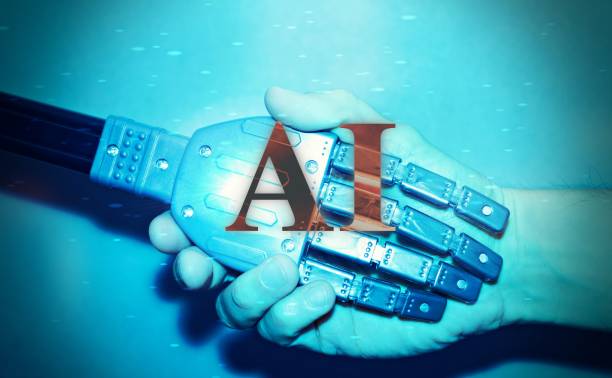
Using AI robots has many advantages, but at the same time, it also has disadvantages that must be considered.
Among the advantages of using AI robots are increased efficiency, reduced costs, increased accuracy, improved quality, reduced risks, and increased speed.
AI robots can work 24 hours a day and perform their tasks without fatigue or reduced performance.
This significantly increases production and services.
Also, AI robots can perform dangerous and repetitive tasks and prevent human injury.
Among the disadvantages of using AI robots are the high cost of purchase and maintenance, the need for expertise for programming and maintenance, the potential for job losses, and ethical issues.
AI robots require programming and maintenance, and if a problem occurs, costly repairs may be required.
Also, the use of AI robots may lead to the loss of jobs that were previously done by humans.
Finally, ethical issues related to the use of AI robots should also be considered, including accountability for robot decisions and maintaining information privacy.
Therefore, the use of AI robots should be done carefully and with planning to benefit from its advantages and minimize its disadvantages.
Are you unhappy with the low conversion rate of visitors to customers on your online store?
Solve this problem forever with professional online store design by Rasaweb!
✅ Increase the visitor-to-customer conversion rate
✅ Create a great user experience and build customer trust
⚡ Get free advice
Challenges of Implementing AI Robots

Implementing AI robots faces various challenges that must be considered.
One of the main challenges is the high cost of research and development and equipment purchases.
AI robots require advanced technologies and specialized knowledge and require a lot of investment.
Another challenge is the shortage of specialists in the field of robotics and artificial intelligence.
For programming, maintenance, and repair of AI robots, trained and skilled people are needed.
Another challenge is issues related to security and privacy.
AI robots can collect and process sensitive information and must be protected from unauthorized access.
Also, ethical issues related to the use of AI robots should also be considered, including accountability for robot decisions and its impact on society.
Finally, the challenge of social acceptance of AI robots should also be considered.
Some people may be concerned about job losses or the misuse of AI robots, and it is necessary to address their concerns by providing accurate and transparent information.
To overcome these challenges, cooperation between government, industry, and academia is needed.
The government can encourage research and development in the field of robotics and artificial intelligence by providing facilities and financial support.
Industry can commercialize new technologies by investing in this field.
The university can meet the needs of the industry by training specialists and providing the necessary training.
The Future of AI Robots and Their Impact on Our Lives

The future of AI robots is very bright and full of opportunities.
With the advancement of technology, AI robots will be able to perform more complex tasks and play a more prominent role in various industries.
It is expected that in the future, AI robots will have a greater presence in our daily lives and help us perform various tasks.
For example, home robots can help us with household chores such as cleaning, cooking, and caring for the elderly and children.
Educational robots can help students learn different subjects and provide personalized education.
Medical robots can help doctors diagnose diseases and provide more effective treatments.
Transportation robots can help drivers drive and reduce accidents.
However, it should be noted that the advancement of AI robots requires attention to ethical and social issues.
It must be ensured that AI robots act in the benefit of society and do not violate the rights and privacy of individuals.
Also, the impact of AI robots on the labor market should be considered and programs should be provided for training and re-employment of people who lose their jobs.
Machine Learning and its Role in the Development of AI Robots
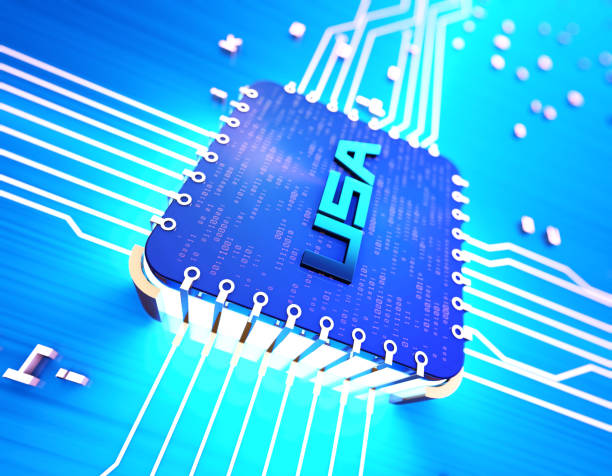
Machine Learning plays a very important role in the development of AI robots.
Machine learning allows robots to learn from data and improve their performance without being explicitly programmed.
In other words, instead of programmers defining all possible states for the robot, the robot can use machine learning algorithms to identify patterns and relationships in the data and make decisions based on them.
This makes the robot smarter, more flexible, and more adaptable to its environment.
There are various machine learning algorithms, each of which is suitable for specific applications.
Some of these algorithms include Supervised Learning, Unsupervised Learning, and Reinforcement Learning.
In supervised learning, the robot is trained using labeled data and learns how to map inputs to desired outputs.
In unsupervised learning, the robot is trained using unlabeled data and learns to identify hidden patterns and structures in the data.
In reinforcement learning, the robot learns how to act in a specific environment to achieve its goal by trial and error and receiving rewards and punishments.
Machine learning plays a key role in making robots intelligent.
| Algorithm | Description | Application |
|---|---|---|
| Supervised Learning | Training using labeled data | Object detection, image classification |
| Unsupervised Learning | Training using unlabeled data | Data clustering, dimensionality reduction |
| Reinforcement Learning | Learning through trial and error and receiving rewards and punishments | Robot control, computer games |
| Role | Description |
|---|---|
| Learning from Data | The robot can identify patterns and relationships using data |
| Improving Performance | The robot can improve its performance by learning from its experiences |
| Flexibility | The robot can perform well in new and unexpected situations |
Ethics in Robotics and Artificial Intelligence

With the increasing use of AI robots, ethical issues related to this technology are becoming more important.
One of the main ethical issues is accountability for robot decisions.
If an AI robot makes a decision that results in harm to people or financial loss, who will be responsible? The robot manufacturer, its programmer, or the robot itself? These questions require careful consideration and the establishment of appropriate rules and regulations.
Another ethical issue is maintaining information privacy.
AI robots can collect a lot of information about people and this information must be protected from misuse.
Also, it should be noted that AI robots should not be used for discrimination or violation of human rights.
To solve these ethical issues, it is necessary to develop ethical principles and standards for robotics and artificial intelligence.
These principles should include items such as accountability, transparency, fairness, privacy, and security.
Also, attention should be paid to education and awareness about ethical issues related to AI robots so that people can make informed decisions about the use of this technology.
IEEE Ethics is a reliable source in the field of ethics in technology.
Did you know that the first impression customers have of your company is your website? With a powerful corporate website from Rasaweb, multiply the credibility of your business!
✅ Exclusive and eye-catching design tailored to your brand
✅ Improving user experience and increasing customer acquisition
⚡ Get free advice!
The Role of AI Robots in Education
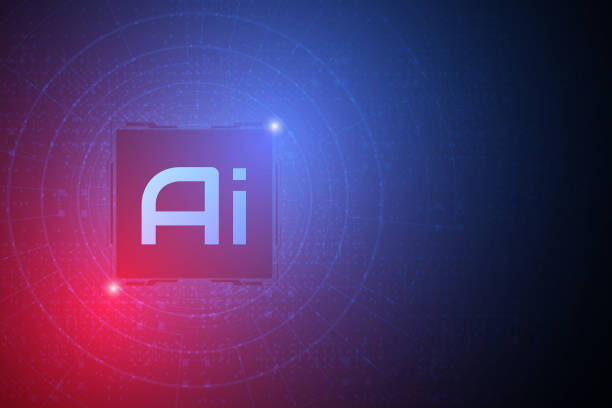
AI robots can play an important role in education and provide new methods for learning and teaching.
One of the applications of AI robots in education is providing personalized education.
AI robots can analyze data related to students, identify their strengths and weaknesses, and provide appropriate educational content based on them.
This allows students to learn more effectively and progress.
Another application of AI robots in education is providing interactive education.
AI robots can interact with students and answer their questions.
This makes students more involved in the learning process and more motivated to learn.
AI robots can help teachers with various tasks.
AI robots can perform tasks such as correcting exam papers, providing feedback to students, and planning lessons.
This allows teachers to spend more time teaching and interacting with students.
ISTE is an international organization that promotes the use of technology in education.
However, it should be noted that the use of AI robots in education should not replace the role of teachers.
Teachers play an important role in motivating, guiding, and supporting students, and AI robots can only help them perform these tasks.
How to Build an AI Robot? – A Basic Guide
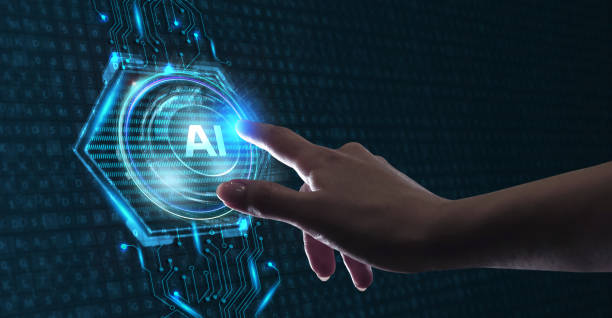
Building an AI robot can be an exciting and challenging project.
To get started, you need basic knowledge in the fields of robotics, electronics, and programming.
First, you need to choose a suitable hardware platform.
This platform can include a development board such as Arduino or Raspberry Pi, sensors, actuators, and a power source.
Then you need to choose the required AI software.
This software can include a machine learning library such as TensorFlow or PyTorch and a programming language such as Python.
After choosing hardware and software, you need to start programming.
First, you need to set up the sensors and collect data.
Then you need to implement machine learning algorithms and train the robot.
Finally, you need to test the robot and improve its performance.
Building an AI robot requires patience, perseverance, and continuous learning.
With practice and effort, you can build a smart and useful robot.
Arduino and Raspberry Pi are two popular platforms for building robots.
Of course, building a complex AI robot requires more expertise and experience.
In this case, it is better to get help from experts and consultants in this field.
Frequently Asked Questions
| Row | Question | Answer |
|---|---|---|
| 1 | What is an AI robot? | An AI robot is a machine that is capable of understanding, reasoning, learning, and problem-solving, and can perform complex tasks with relative autonomy. |
| 2 | What are the most important applications of AI robots? | The main applications include industrial production, customer service (chatbots), medicine and surgery, self-driving transportation, space exploration, and military affairs. |
| 3 | What is the main difference between an AI robot and a regular robot? | A regular robot only follows programmed instructions, while an AI robot can learn from data, make decisions, and adapt to new environments. |
| 4 | How do AI robots learn? | They identify patterns and improve their performance through machine learning algorithms (such as deep learning, reinforcement learning) and processing vast amounts of data. |
| 5 | Can AI robots have emotions? | Currently, AI robots do not have real emotions in the human sense. They can imitate or recognize emotions, but they do not understand and experience them. |
| 6 | What are the current limitations of AI robots? | Limitations include the need for large amounts of data, the inability to understand abstract concepts, the lack of real creativity, ethical issues, and the challenges of generalization in new environments. |
| 7 | What is the role of AI in the development of humanoid robots? | AI helps humanoid robots walk, maintain balance, understand their environment, interact with humans, and perform complex tasks. |
| 8 | How is the future of AI robots predicted? | It is predicted that AI robots will become smarter, more autonomous, and capable of performing more complex tasks in everyday life and industry, and their interaction with humans will increase. |
| 9 | Can AI robots replace all human jobs? | It is unlikely that all human jobs will be replaced. Robots will take over many repetitive and dangerous tasks, but jobs that require creativity, empathy, and ethical judgment will remain. |
| 10 | What ethical and social challenges arise with the expansion of AI robots? | Challenges include issues related to privacy, data security, ethical decision-making by robots, impact on employment, and accountability in case of errors. |
And other services of Rasa Web advertising agency in the field of advertising
Smart Reportage: A creative platform for improving campaign management with proprietary programming.
Smart Google Ads: Professional optimization for campaign management using SEO-focused content strategy.
Smart Marketing Automation: A new service to improve SEO ranking by optimizing key pages.
Smart Sales Automation: Transform SEO ranking with an attractive user interface design.
Smart Content Strategy: Professional optimization for attracting customers by customizing the user experience.
And more than a hundred other services in the field of internet advertising, advertising consulting, and organizational solutions
Internet Advertising | Advertising Strategy | Reportage Ad
Sources
Smart Robots Chance to Replace Workers in Today’s Industry?
,Building Intelligent Robots with the Ability to Read Human Results
,The Best Practical Smart Robots in the World
,Artificial Intelligence, Putting Robots at the Service of Humanity; Iranian Advanced Gadgets Science Decided
? Afarin Rasaweb Digital Marketing Agency is with you to be seen and grow your business in the digital world. From custom website design to SEO optimization and advertising campaign management, we pave your path to success.
📍 Tehran, Mirdamad Street, next to the Central Bank, South Kazerun Alley, Ramin Alley No. 6


